Shaping Tomorrow’s Mobility: Exploring Ev Powertrain Progressions and Asia Pacific’s Market Supremacy
Author: Vikas Kumar
06 January 2024
INTRODUCTION
The powertrain of a vehicle is responsible for generating the power needed to move its wheels. Electric vehicles feature a much simpler powertrain system, comprising a far smaller number of components than those of vehicles powered by an internal combustion engine. Generally, the EV powertrain consists of a battery pack, inverters for power transfer, and one or more electric motors connected by a final reduction drive. Hybrid vehicles and plug-in hybrid vehicles incorporate additional components in the powertrain, such as an internal combustion engine, dedicated transmission, and exhaust system. According to the report published by the UnivDatos Market Insights the Global Electric Vehicle Powertrain market is USD 235.7 billion and is expected to reach USD 1,725.1 billion by 2030.
Access sample report (including graphs, charts, and figures): https://univdatos.com/get-a-free-sample-form-php/?product_id=47156
Fig 1. Global Sales for Various Electric Vehicles, 2010-2022
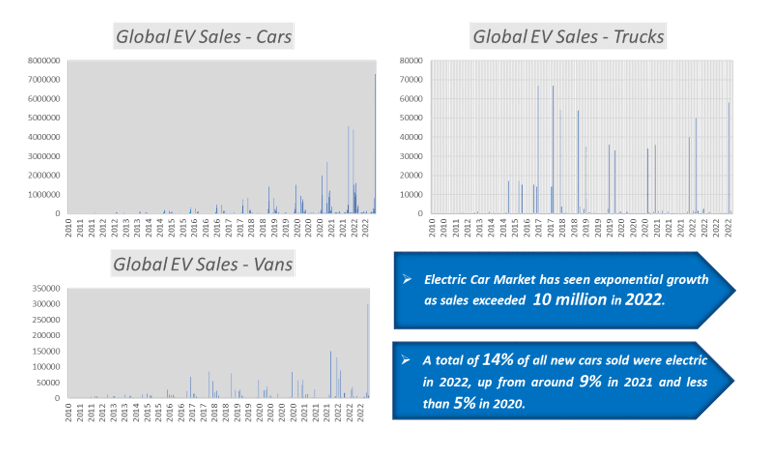
The electric vehicle (EV) industry has experienced a remarkable surge in growth in recent years, driven by advances in technology and heightened environmental consciousness. The powertrain lies at the crux of this revolution, the intricate system responsible for transforming electrical energy into mechanical energy for propulsion.
Figure 2: Electric Vehicle Powertrain Component with a % share in terms of price
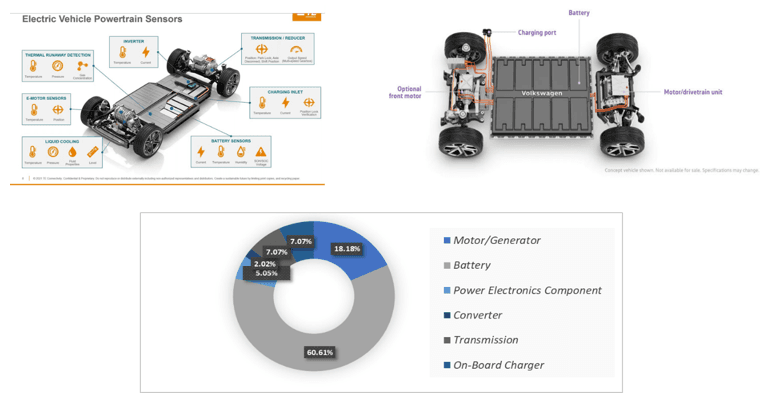
BATTERIES
The foundation of any electric vehicle powertrain lies in the battery, and with the emergence of lithium-ion batteries, there has been a revolution in the EV landscape. This has brought about greater energy density, enhanced charging capabilities, and longer lifespans, resulting in extended driving ranges for electric vehicles. As battery technology continues to advance with the exploration of solid-state batteries and other cutting-edge developments, one can anticipate even greater progress in range, charging speed, and cost reduction.
Figure 3: Electric Vehicle Batteries Snapshot
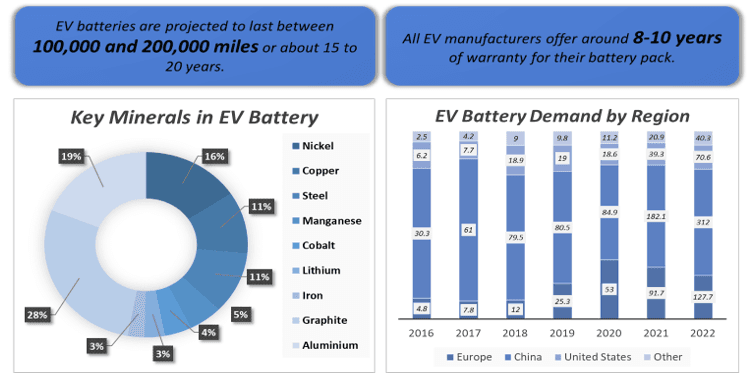
EFFICIENT MOTORS
Efficiency of motors is essential to maximize the potential of electric vehicles. Permanent Magnet Synchronous Motors (PMSMs) have emerged as the preferred option as they are renowned for their high efficiency, compact size, and torque characteristics. Recent advancements in motor design, such as the integration of advanced materials and optimized magnet configurations, have increased power output and improved overall efficiency. Furthermore, with the incorporation of motor control algorithms and predictive software, smoother acceleration, regenerative braking, and accurate control of torque can be achieved, leading to an optimal driving experience.
Unlock Insights: Receive a Sample Research Report on the Middle East EV Powertrain Market – https://univdatos.com/report/middle-east-ev-powertrain-market/
POWER ELECTRONICS
Power electronics form an essential link between the battery, motor, and other components of the powertrain. These electronic systems, such as inverters, converters, and motor controllers, effectively manage the flow of electrical energy, optimizing both efficiency and performance. The development of power electronics has reduced energy losses, improved thermal management, and increased power density, resulting in more economical and compact powertrains. Furthermore, innovations in silicon carbide (SiC) and gallium nitride (GaN) semiconductors are anticipated to revolutionize power electronics, facilitating higher switching speeds and reduced losses.
INTELLIGENT SOFTWARE
Intelligent software solutions have become essential for powertrain evolution. Advanced algorithms and machine learning techniques can optimize powertrain efficiency, adjust to changing environmental conditions, and improve performance. By drawing upon real-time data and analyzing driver behavior, predictive controls enable optimal energy usage, predictive maintenance, and customized driving experiences. As the industry continues to embrace connectivity and vehicle-to-grid integration, software developments will remain crucial for the advancement of powertrain optimization and intelligent energy management.
REGIONAL ANALYSIS
According to the report published by the UnivDatos Market Insights the Global Electric Vehicle Powertrain market, is dominated by the Asia Pacific region with the almost conquered the 59.2% market share in 2022 and expected to dominate the market in 2030 with an approximately of market share of 63.4% in 2030. The demand for electric vehicle batteries in the Asia-Pacific region is growing rapidly due to several factors, including government policies, technological advances, investment by battery manufactures and economic growth. Additionally, the region is the world’s largest automobile market, with governments in nations such as China, Japan and South Korea actively encouraging the adoption of electric vehicles to reduce air pollution and carbon emissions. This has resulted in an increased demand for EVs, which has subsequently generated a demand for EV powertrains. The adoption of Electric Vehicle (EV) batteries is rapidly increasing in the Asia Pacific region due to heightened awareness of air pollution and its associated health risks. Areas within the Asia Pacific region have experienced alarming levels of air pollution, and the adoption of EVs have shown to be effective in reducing emissions and improving air quality. China, for example, has established a target for the sales of new energy vehicles to account for 20% of new car sales by 2025. Additionally, the high uptake of EV powertrains is resulting in a wide range of affordable EV models. Over the past few years, numerous automakers, such as Hyundai and Kia, have released cost-effective EV models with larger ranges and faster charging capabilities, thereby making them more attractive to buyers.
Fig 4: Comparative Analysis of Electric Vehicle Powertrain Market Share between 2022 & 2030.
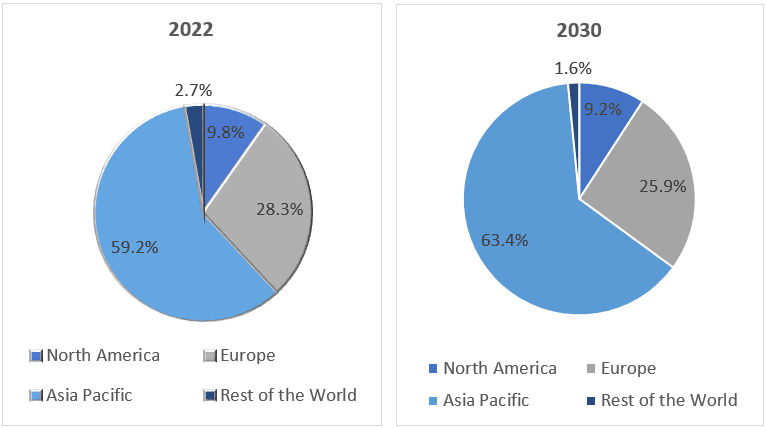
ELIMINATION OF COMBUSTION ENGINES AND MOVEMENT TO ELECTRIC VEHICLES
One of the biggest and most major concerns the world has ever faced is moderating climate change by reducing carbon emissions. Technological innovation plays a critical role in tackling this challenge, prompting old and new industrial powers to reform their policy frameworks to incentivize low-carbon investment and innovation. For EVs to contribute to cutting vehicle emissions, it is necessary to integrate them into power systems, decarbonize electricity generation, deploy recharging infrastructure, and manufacture sustainable batteries. To further this goal, more than 20 countries have announced the full phase-out of internal combustion engine (ICE) car sales within 10-30 years, with emerging economies such as Cabo Verde, Costa Rica, and Sri Lanka being among the adopters. Building upon this, more than 120 countries (accounting for around 85% of the global road vehicle fleet, excluding two/three-wheelers) have presented pledges of net-zero emissions in the coming decades.
Figure 5: Internal Combustion Engine Bans or Electrification Targets
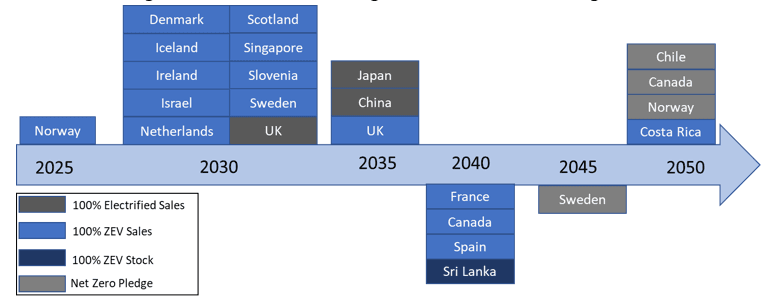
CONCLUSION
According to the report published by the UnivDatos Market Insights the Global Electric Vehicle Powertrain market, the electric vehicle powertrain market is set to witness significant growth in the coming Syears, driven by advancements in battery technology, efficient motors, power electronics, and intelligent software solutions. The time has come to delve into the intricate details of the electric vehicle powertrain market. Batteries, motors, power electronics, and software solutions are working in tandem to power the transformation from electrical energy to mechanical energy for locomotion. Furthermore, lithium-ion batteries are offering high energy density and charging capabilities, along with technological advancements to extend range and accelerate charging speed. Additionally, PMSMs and semiconductor materials are being utilized to develop more efficient control algorithms and predictive software, resulting in a smoother and more efficient powertrain system. In addition, Asia Pacific is dominating the global market due to government policies and incentives that lead to increased electric vehicle adoption, creating a stable and innovative powertrain market.
Get a call back
